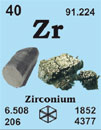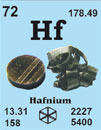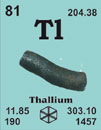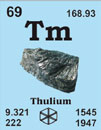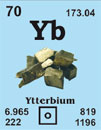Tellur 52Te127.60
1783 von Baron Franz Joseph Müller von Reichenstein in Sibiu, Rumänien, entdeckt.
[Lateinisch, tellus = Erde]
French: tellure
English: tellurium
Italian: tellurio
Spanish: teluro
Beschreibung: Kompakt is es silberweiß und metallisch aussehend, gewöhnlich wird es als dunkel-graues Pulver erhalten. Halbmetall. Verbrennt in Luft oder Sauerstoff. Wird von Wasser oder HCl nicht angegriffen, löst sich aber in HNO3. Verwendung: Chemikalien, Katalysatoren, Elektronik, Legierungen.
Tellur single crystal properties
| State: |
Single crystal |
|---|
| Crystal structure: |
Hexagonal |
|---|
| Production method: |
Czochralski |
|---|
| Standard size: |
diameter 10mm
thickness 1-2mm |
|---|
| Orientation: |
(0001), (1100) and (11-20) |
|---|
| Orientation accuracy: |
<2°, <1°, <0.4° or <0.25° |
|---|
| Polishing: |
as cut, one or two sides polished |
|---|
| Roughness of surface: |
<0.03µm |
|---|
| Purity: |
99.999% |
|---|
| Typical analysis (ppm): |
C 3
H < 1
O 9
N < 5
Cu 1.60
Fe 1.80
Ni < 1
Pb 0.30
Si 0.30
Ga, Hf and Ta are below the detection limit
|
|---|
Materials properties
| Density: |
6.24 g/cm3 |
|---|
| Melting point: |
449.55 °C / 722.7 °K |
|---|
| Boiling point: |
989.85 °C / 1263.0 °K |
|---|
| Molar volume: |
20.45 cm3 |
|---|
| Thermal conductivity: |
2.35 [300 K] Wm-1K-1 |
|---|
| Coefficient of linear thermal expansion: |
16.75 x 10-6 K-1 |
|---|
| Electrical resistivity: |
4.36x 10-3 [298 K] Wm |
|---|
| Mass magnetic susceptibility: |
-3.9 x 10-9(s) kg-1m3 |
|---|
| Young's modulus: |
47.1 GPa |
|---|
| Rigidity modulus: |
16.7 GPa |
|---|
| Bulk modulus: |
n.a. GPa |
|---|
| Poisson's ratio: |
0.16 - 0.3 GPa |
|---|
| Radii: |
Te3+ 56; Te4+ 97; Te2- 211; atomic 143; covalent 1 |
|---|
| Electronegativity: |
2.1 (Pauling); 2.01 (Allred); 5.49 eV (absolute) |
|---|
| Effective nuclear charge: |
6.95 (Slater); 10.81 (Clementi); 13.51 (Froese-Fischer) |
|---|
| Number of Isotopes (incl. nuclear isomers): |
39 |
|---|
| Issotope mass range: |
108 -> 137 |
|---|
| Crystal structure, (cell dimentions / pm), space group |
Hexagonal |
|---|
| X-ray diffraction: mass absorption coefficients: |
CuKα 282 (µ/r) / cm2g-1
MoKα 35.0 (µ/r) / cm2g-1 |
|---|
| Neutron scattering length: |
0.580 b/10-12 cm |
|---|
| Thermal neutron capture cross-section: |
4.7 sa / barns |
|---|
Biological data
| Biological role: |
none |
|---|
| Toxicity |
|
|---|
| Toxic intake: |
Elemental tellurium has low toxicity but unpleasant side effects, producing extremely unpleasant bre |
|---|
| Lethal intake: |
2 g of sodium tellurite has proved fatal to a human. LD50 (Te metal, oral, rat)= 83 mg kg-1 |
|---|
| Hazards: |
Tellurium compounds are toxic by ingestion and intravenous routes. They are also considered to be experimental tetratogens. |
|---|
| Level in humans |
|
|---|
| Blood: |
0.0055 mg dm-3 |
|---|
| Bone: |
n.a. |
|---|
| Liver: |
0.014 p.p.m. |
|---|
| Muscle: |
0.017 p.p.m. |
|---|
| Daily dietary intake: |
c. 0.6 mg |
|---|
| Total mass of element in average [70 kg] person: |
c. 0.7 mg |
|---|
Geological data
| Mineral | Formula | Density | Hardness | Crystal apperance |
|---|
| Sylvanite |
AgAuTe4 |
8.16 |
1.5 - 2 |
mon., met. grey |
|---|
| Tellurite |
TeO2 |
5.90 |
2 |
orth., sub-adamantine white |
|---|
| Chief ore: |
none mined as such. Tellurium is obtained from the anode slime of copper refining. |
|---|
| World production: |
215 tonnes/year |
|---|
| Main mining areas: |
Sylvanite in Australia, USA and Romania |
|---|
| Reserves: |
n.a. |
|---|
| Specimen: |
available as granules, ingots, pieces or powder. DANGER ! |
|---|
| Abundances |
|
|---|
| Sun: |
n.a. |
|---|
| Earth's crust: |
c. 0.005 p.p.m. |
|---|
| Seawater: |
|
|---|
| Residence time: |
|
|---|
| Classification: |
scavenged |
|---|
| Oxidation state: |
IV and VI; mainly VI |
|---|

 English
English
 Deutsch
Deutsch








































